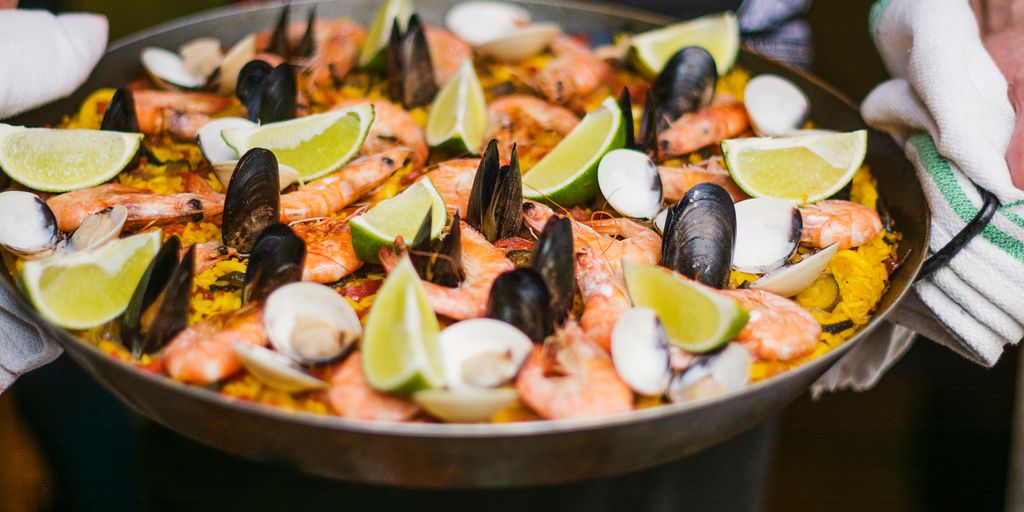Food
The Ultimate Guide to Making Spanish Paella

This guide is designed to help you understand everything about making Spanish paella, from its rich history to the best ways to cook it. Paella is more than just a dish; it’s a celebration of culture, flavours, and community. Whether you’re a beginner or looking to refine your skills, this ultimate guide will provide you with all the essential knowledge and tips you need to create the perfect paella.
Key Takeaways
- Paella originated in Valencia, Spain, and has many regional varieties.
- Choosing the right type of rice is crucial for a good paella.
- A paella pan is essential for cooking, but you can use alternatives if needed.
- Sofrito is a key part of paella, adding depth and flavour.
- Pairing the right wine can enhance your paella experience.
History and Origins of Spanish Paella
The Birthplace of Paella
Paella is a famous dish that comes from Valencia, a region in Spain. It started in the rural areas, especially near the Albufera, around the 15th or 16th century. This dish was originally made by farmers and labourers who cooked rice over an open fire using whatever ingredients they had available.
Traditional Variations Across Spain
There are many different types of paella, each with its own unique twist. Here are some popular variations:
- Valencian Paella: The classic version, made with chicken, rabbit, and green beans.
- Seafood Paella: A delicious mix of various seafood like shrimp, mussels, and fish.
- Vegetarian Paella: A healthy option that includes a variety of vegetables and sometimes beans.
Cultural Significance of Paella
Paella is more than just a meal; it is a symbol of Spanish culture. It is often served during family gatherings and celebrations. The dish brings people together, making it a staple at festivals and special occasions.
Paella is not just food; it represents the heart of Spanish traditions and family values.
In summary, paella has a rich history that reflects the agricultural roots of Valencia and the diverse culinary traditions of Spain. Its variations showcase the creativity and local ingredients of different regions, making it a beloved dish worldwide.
Essential Ingredients for Authentic Paella

Selecting the Right Rice
Choosing the right rice is crucial for making paella. The best types are:
- Bomba: Absorbs a lot of liquid and stays firm.
- Calasparra: Similar to Bomba, it’s also great for paella.
- Arroz de Valencia: A traditional choice that works well too.
Key Proteins and Vegetables
Paella can include a variety of proteins and vegetables. Here are some common options:
- Chicken: A classic choice for many paellas.
- Rabbit: Often used in traditional Valencian paella.
- Seafood: Such as shrimp, mussels, and squid for a seafood version.
- Green Beans: Adds texture and flavour.
- Tomatoes: Fresh or canned, they are essential for the base.
The Role of Saffron and Spices
Saffron is the star spice in paella, giving it a unique flavour and colour. Here’s how to use it:
- Saffron Threads: Use a pinch to infuse the dish with its distinct taste.
- Paprika: Adds depth and a smoky flavour.
- Salt and Pepper: Essential for seasoning the dish to perfection.
Remember, the quality of your ingredients can make or break your paella. Using fresh, authentic ingredients will enhance the overall taste and experience of this beloved dish.
Choosing the Perfect Paella Pan
When it comes to making paella, the right pan is essential for achieving the best results. Here are some key points to consider when selecting your paella pan:
Size and Material Considerations
- Size: Choose a pan that fits the number of servings you need. Common sizes range from 30 cm to 60 cm in diameter.
- Material: Traditional paella pans are made from polished steel or stainless steel, which conduct heat evenly. Cast iron is also a good option for heat retention.
- Shape: A wide, shallow pan is ideal for even cooking and achieving that perfect socarrat.
Caring for Your Paella Pan
- Cleaning: Avoid using soap on your pan. Instead, rinse it with hot water and scrub gently.
- Seasoning: If you have a cast iron pan, season it regularly to maintain its non-stick surface.
- Storage: Store your pan in a dry place to prevent rusting.
Alternatives to Traditional Pans
If you don’t have a paella pan, consider these alternatives:
- Frying Pan: A large frying pan can work in a pinch.
- Wok: A wok can also be used, but it may not give the same results.
- Oven-Safe Dish: You can use a large oven-safe dish for baking paella.
Choosing the right paella pan can make a big difference in your cooking experience. The Garcima Pata Negra paella pan is highly recommended for its performance and versatility, making it suitable for any gathering, whether you’re a beginner or an expert.
Mastering the Art of Sofrito
Ingredients for a Flavourful Sofrito
To create a delicious sofrito, you will need the following key ingredients:
- Olive oil: The base for your sofrito, providing richness.
- Onions: Finely chopped, they add sweetness and depth.
- Garlic: Minced, for a strong flavour.
- Tomatoes: Fresh or canned, they bring acidity and moisture.
- Bell peppers: Chopped, for colour and crunch.
Cooking Techniques for Sofrito
- Heat the oil in a pan over medium heat.
- Add the onions and cook until they are soft and translucent.
- Stir in the garlic and cook for another minute, being careful not to burn it.
- Add the tomatoes and bell peppers, cooking until everything is well combined and the mixture thickens.
- Season with salt and pepper to taste.
Common Mistakes to Avoid
- Burning the garlic: Always add it after the onions are soft.
- Using too much heat: Sofrito should be cooked slowly to develop flavours.
- Not cooking long enough: Allow the mixture to simmer until it’s rich and thick.
A well-made sofrito is the heart of any paella, providing a foundation of flavour that enhances the entire dish.
By mastering these techniques, you can elevate your paella to new heights!
Step-by-Step Guide to Cooking Paella

Preparing the Ingredients
To make a delicious paella, start by gathering all your ingredients. Here’s a simple list to follow:
- Rice: Use short-grain rice like Bomba or Calasparra.
- Proteins: Choose chicken, rabbit, or seafood based on your preference.
- Vegetables: Bell peppers, green beans, and tomatoes are great choices.
- Broth: Use chicken or fish stock for added flavour.
Layering and Cooking Techniques
Once your ingredients are ready, follow these steps:
- Heat olive oil in your paella pan.
- Add proteins and cook until browned.
- Stir in vegetables and cook for a few minutes.
- Add rice and mix well with the other ingredients.
- Pour in the broth and let it simmer without stirring.
Achieving the Perfect Socarrat
The socarrat is the crispy layer of rice at the bottom of the pan. To achieve this:
- Increase the heat for the last few minutes of cooking.
- Avoid stirring once the broth is added.
- Listen for a crackling sound, which indicates the socarrat is forming.
Cooking paella is an art that requires patience and practise. With the right techniques, you can create a dish that impresses everyone.
Pairing Paella with the Right Wine
When it comes to enjoying paella, the right wine can elevate the experience. Here are some tips to help you choose the perfect wine to complement your dish:
Wine Varieties That Complement Paella
- White Wines: Look for crisp and refreshing options like:
- Albariño
- Verdejo
- Sauvignon Blanc
- Red Wines: If you prefer red, consider:
- Tempranillo
- Garnacha
- Monastrell
- Rosé Wines: A dry rosé can also be a great match.
Regional Wine Pairings
Different regions in Spain have their own specialties. Here’s a quick guide:
| Region | Recommended Wine |
|---|---|
| Valencia | Bobal |
| Andalusia | Fino Sherry |
| Catalonia | Cava |
Non-Alcoholic Options
If you’re looking for non-alcoholic choices, consider:
- Sparkling water with lemon
- Herbal teas
- Non-alcoholic wines
Choosing the right wine is about enhancing the flavours of your paella, making each bite more enjoyable. Remember, it’s all about personal preference!
Serving and Presentation Tips

Traditional Ways to Serve Paella
- Serve directly from the pan: This is the most authentic way to enjoy paella. It creates a communal atmosphere.
- Use a large wooden spoon: This helps in serving generous portions and adds to the rustic feel.
- Garnish with lemon wedges: Fresh lemon adds a zesty touch that enhances the flavours.
Garnishing for Visual Appeal
- Fresh herbs: Sprinkle chopped parsley or coriander for a pop of colour.
- Saffron strands: A few strands on top can make the dish look luxurious.
- Vegetable slices: Arrange slices of bell peppers or tomatoes around the edge for a vibrant presentation.
Serving Paella at Events
- Buffet style: Set up a buffet where guests can serve themselves, allowing them to choose their portions.
- Individual servings: For a more formal event, serve paella in individual bowls or plates.
- Accompany with sides: Offer a selection of sides like crusty bread or a fresh salad to complement the meal.
Remember, presentation is key! A well-presented paella not only looks appetising but also enhances the overall dining experience.
When serving paella, it’s important to create a warm and inviting atmosphere. Using a large paella pan not only makes it easier to serve but also adds to the charm of the dish.
Summary Table of Serving Tips
| Tip | Description |
|---|---|
| Serve from the pan | Creates a communal dining experience |
| Use a wooden spoon | Helps in serving generous portions |
| Garnish with lemon | Adds freshness and enhances flavours |
Exploring Regional Paella Recipes
Paella is not just one dish; it varies greatly across different regions of Spain. Each area has its own unique twist, making it a delightful experience to explore these variations. From the coastal seafood delights to the hearty meat versions, there’s a paella for everyone.
Valencian Paella
Valencian paella is the original version, hailing from Valencia. It typically includes:
- Chicken
- Rabbit
- Green beans
- Saffron
- Rosemary
This dish is often cooked over an open flame, giving it a distinct smoky flavour.
Seafood Paella
Seafood paella is popular in coastal regions. It usually features:
- Prawns
- Mussels
- Calamari
- Fish
- Saffron
This version is lighter and perfect for those who love the taste of the sea.
Vegetarian and Vegan Paella
For those who prefer plant-based meals, vegetarian and vegan paella is a great option. Common ingredients include:
- Artichokes
- Peas
- Bell peppers
- Tomatoes
- Saffron
This variation is not only delicious but also packed with nutrients.
Exploring these regional recipes allows you to appreciate the rich diversity of Spanish cuisine. Each paella tells a story of its origin, ingredients, and the people who make it.
In summary, whether you enjoy the traditional Valencian style, the fresh seafood version, or a hearty vegetarian option, paella offers something for everyone. Discovering these regional recipes can enhance your cooking skills and broaden your culinary horizons.
Troubleshooting Common Paella Problems
Cooking paella can sometimes lead to a few common issues. Here’s how to tackle them effectively:
Avoiding Overcooked Rice
- Use the right rice: Choose short-grain rice like Bomba or Calasparra for the best texture.
- Monitor cooking time: Keep an eye on the clock; rice usually takes about 18-20 minutes to cook.
- Don’t stir too much: Once you add the rice, avoid stirring to prevent it from becoming mushy.
Balancing Flavours and Seasonings
- Taste as you go: Regularly sample your paella to adjust the seasoning.
- Add salt gradually: Start with a small amount and increase as needed.
- Incorporate fresh herbs: Adding parsley or thyme can enhance the overall flavour.
Dealing with Excess Liquid
- Check your broth: Ensure you’re using the right amount of liquid; typically, it’s 2 parts liquid to 1 part rice.
- Increase heat: If there’s too much liquid, raise the heat to help it evaporate.
- Let it rest: After cooking, let the paella sit for a few minutes to absorb any remaining liquid.
Remember, practise makes perfect! Each time you cook paella, you’ll learn something new and improve your skills.
Sourcing Quality Ingredients

When it comes to making authentic paella, sourcing quality ingredients is crucial. Fresh and high-quality ingredients can make a significant difference in the final dish. Here are some tips to help you find the best ingredients:
Finding Authentic Spanish Ingredients
- Look for local Spanish markets or specialty stores.
- Check online retailers that specialise in Spanish foods.
- Ask for recommendations from friends or cooking groups.
Local Alternatives and Substitutes
If you can’t find specific Spanish ingredients, consider these alternatives:
- Rice: Use Arborio or Carnaroli rice if Bomba is unavailable.
- Saffron: Turmeric can be a substitute, though the flavour will differ.
- Seafood: Fresh local seafood can replace traditional Spanish varieties.
Online Shopping Tips
- Compare prices from different websites to find the best deals.
- Read reviews to ensure the quality of the products.
- Look for stores that offer free shipping on larger orders.
Sourcing the right ingredients is the first step to creating a delicious paella. Always prioritise quality over quantity to ensure the best results in your cooking!
Health Benefits of Eating Paella
Nutritional Value of Paella
Paella is not just a delicious dish; it also offers several nutritional benefits. It typically includes a variety of ingredients that contribute to a balanced diet. Here are some key components:
- Rice: A good source of carbohydrates, providing energy.
- Proteins: Depending on the type of paella, you can find chicken, seafood, or vegetables, all of which are essential for muscle growth and repair.
- Vegetables: Ingredients like peas, bell peppers, and tomatoes add vitamins and minerals.
Incorporating Paella into a Balanced Diet
To enjoy paella while maintaining a healthy lifestyle, consider the following tips:
- Portion Control: Serve smaller portions to avoid overeating.
- Add More Veggies: Increase the amount of vegetables in your paella for added nutrients.
- Choose Lean Proteins: Opt for chicken or seafood instead of fatty meats.
Healthier Variations of Paella
There are many ways to make paella healthier:
- Vegetarian Paella: Use a variety of vegetables and legumes.
- Quinoa Paella: Substitute rice with quinoa for extra protein and fibre.
- Low-Sodium Broth: Use low-sodium broth to reduce salt intake.
Eating paella can be a delightful way to enjoy a meal that is both tasty and nutritious. By choosing the right ingredients, you can make it a healthy option for any occasion.
Summary Table of Nutritional Benefits
| Ingredient | Nutritional Benefit |
|---|---|
| Rice | Energy source |
| Proteins | Muscle growth and repair |
| Vegetables | Vitamins and minerals |
Conclusion
In summary, making Spanish paella is a fun and rewarding experience. With the right ingredients and a bit of practise, anyone can create this delicious dish at home. Remember, the key is to use fresh produce and to enjoy the cooking process. Whether you prefer seafood, chicken, or a mix of both, paella can be tailored to your taste. So gather your friends and family, and share this wonderful meal together. Happy cooking!
Frequently Asked Questions
What is the best type of rice for paella?
The best rice for paella is Bomba rice, but you can also use Calasparra rice. These types absorb the flavours well and don’t get mushy.
Can I make paella without saffron?
Yes, you can make paella without saffron. If you don’t have it, you can use turmeric for colour, but it will change the taste a bit.
How long does it take to cook paella?
Cooking paella usually takes about 30 to 45 minutes, depending on the recipe and the ingredients you use.
What can I serve with paella?
Paella is often served with a simple salad or some crusty bread. You can also enjoy it with a glass of wine or a refreshing drink.
Is paella a healthy dish?
Paella can be healthy, especially if you include plenty of vegetables and lean proteins. Just be mindful of the portion size.
Can I use a regular pan to cook paella?
While a traditional paella pan is best, you can use a large frying pan or a wide skillet if you don’t have one. Just make sure it’s shallow.
What’s the secret to a good socarrat?
The secret to a good socarrat, which is the crispy bottom layer of rice, is to let the paella cook without stirring it towards the end.
Are there vegetarian options for paella?
Absolutely! You can make a delicious vegetarian paella by using a variety of vegetables, beans, and spices instead of meat or seafood.
-

 Press Release7 days ago
Press Release7 days agoClinical Trials Market Set for Robust Growth, Driven by Drug Development Surge and Digital Innovation
-

 Press Release7 days ago
Press Release7 days agoPediatric Vaccines Market: Safeguarding Futures, Driving Growth
-

 Press Release7 days ago
Press Release7 days agoWaterproof Structural Adhesives Market: A Comprehensive Study Towards USD 10.3 Billion in 2035
-

 Press Release7 days ago
Press Release7 days agoDownhole Tools Market: Navigating Subsurface Frontiers with Precision
-

 Press Release7 days ago
Press Release7 days agoFaropenem Sodium Market: A Potent Weapon in the Fight Against Bacterial Infections













